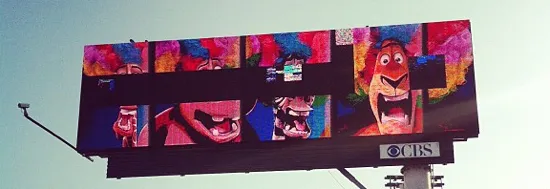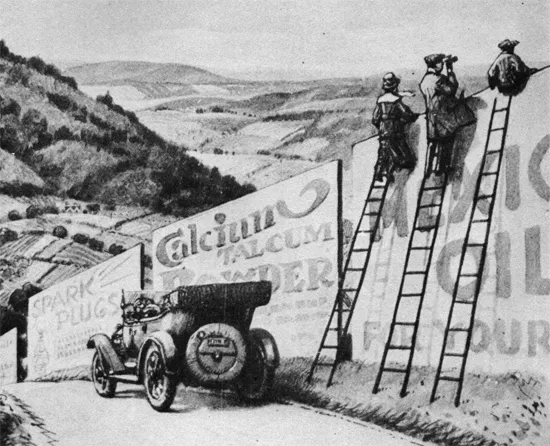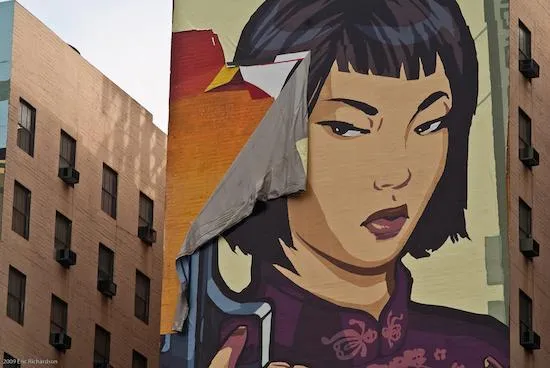Billboard Advertising in the City of Blade Runner
Are Angelenos destined to be perpetually surrounded by super-sized advertisements?
/https://tf-cmsv2-smithsonianmag-media.s3.amazonaws.com/filer/e6/e3/e6e36570-d4f2-4432-82ff-567d6b53bae9/20120427125043blade-runner-470x251.jpg)
New York has the Statue of Liberty, St. Louis has the Gateway Arch and Los Angeles has the Hollywood sign.
It seems rather fitting that the landmark most emblematic of Los Angeles — a city built on glitz and showmanship — is an advertisement.
If you’re at all familiar with the history of the Hollywood sign, you’ll likely remember that it started as an ad for a new housing development in 1923 called Hollywoodland. Using 4,000 light bulbs, the sign was illuminated at night and flashed in three succeeding segments: first “holly,” then “wood,” and then “land.” The sign would then light up in its entirety, all 4,000 light bulbs piercing through the dark of night to the city below.
Los Angeles didn’t invent outdoor advertising (that distinction may belong to the ancient Egyptians, who would post papyrus notices of rewards offered for runaway slaves), but it certainly played a prominent role in the city’s history and its visions of the future. As the automobile took the city by storm in the first half of the 20th century, it became increasingly necessary for advertisers to make their billboards larger so that speeding motorists wouldn’t miss their message.
The 1982 film Blade Runner showed viewers a dark, futuristic version of Los Angeles in the year 2019. Prominent ads for Coca-Cola and Pan Am blink back at you throughout the film, looming large and bright in this highly branded vision of the future.

Today, with digital billboard technology becoming commonplace, local governments all over the country have been fighting advertisers with outright bans. Cities claim that these relatively new forms of outdoor advertising are ugly and distract drivers. Of course, these were the exact claims that the opponents of billboard advertising were making in the early 20th century.

Part of the tremendous growth in outdoor advertising in Los Angeles had to do with the fact that there was relatively little regulation of billboards in California. As the March 1929 California Law Review noted in “Billboard Regulation and the Aesthetic Viewpoint with Reference to California Highways”:
What legislation has been enacted in California on the subject Hardly any. This state prohibits the placing or maintenance of signs on property of the state or its subdivisions “without lawful permission,” or on private property without the consent of the owner or lessee, and the signs so prohibited are declared to be nuisances. A sign erected upon or over a state road or highway without a permit from the department of engineering is further declared to be a public nuisance, punishable as a misdemeanor. This is all the legislation on the subject in this state.
The essay goes on to contrast California’s lax billboard laws with the laws of other states at that time: like Kansas (billboards prohibited within 1000 feet of a highway, even if it’s on private property), Connecticut (billboards prohibited within 100 feet of any public park, state forest, playground or cemetery), or Vermont (billboards must meet the explicit approval of the secretary of state in kind, size and location). Vermont would later go on to make billboards entirely illegal in that state in 1968. In fact, four states (Hawaii, Alaska, Maine and Vermont) all ban billboard advertising anywhere within their borders.
The goal of the California Law Review paper was to propose new laws to regulate billboards. The paper suggested that a progressive tax be placed on billboards based upon their size; that billboards be restricted in areas that are deemed unsafe for motorists, such as at crossings, curves and hills; and that the size of billboards be restricted, the largest being relegated to “commercial districts.”

Today, battles over the regulation of billboards continue in Los Angeles. The last few years have seen major fights over so-called “supergraphics” — gigantic billboards placed on the sides of buildings, stretching many stories tall. They’re incredibly hard to miss — rivaling those predicted by Blade Runner in size, if not electronics — and are scattered around the city, most prominently downtown and along major freeways. The city has sued many of the media companies that negotiate and install these ads, claiming that they’re illegal, and winning over $6 million in lawsuits thus far.
It’s tough to say just how hard the city of Los Angeles will clamp down on the proliferation of billboards — be they digital or merely huge — but for the time being Angelenos will likely remain just this side of a branded, Blade Runner future. With just seven years until 2019, it seems legislation and litigation will be the only thing keeping Los Angeles from achieving full bladerunner.
/https://tf-cmsv2-smithsonianmag-media.s3.amazonaws.com/accounts/headshot/matt-novak-240.jpg)
/https://tf-cmsv2-smithsonianmag-media.s3.amazonaws.com/accounts/headshot/matt-novak-240.jpg)